The Snail repressor recruits EZH2 to specific genomic sites through the enrollment of the lncRNA HOTAIR in epithelial-to-mesenchymal transition
- PMID: 27452518
- PMCID: PMC5318668
- DOI: 10.1038/onc.2016.260
The Snail repressor recruits EZH2 to specific genomic sites through the enrollment of the lncRNA HOTAIR in epithelial-to-mesenchymal transition
Abstract
The transcription factor Snail is a master regulator of cellular identity and epithelial-to-mesenchymal transition (EMT) directly repressing a broad repertoire of epithelial genes. How chromatin modifiers instrumental to its activity are recruited to Snail-specific binding sites is unclear. Here we report that the long non-coding RNA (lncRNA) HOTAIR (for HOX Transcript Antisense Intergenic RNA) mediates a physical interaction between Snail and enhancer of zeste homolog 2 (EZH2), an enzymatic subunit of the polycomb-repressive complex 2 and the main writer of chromatin-repressive marks. The Snail-repressive activity, here monitored on genes with a pivotal function in epithelial and hepatic morphogenesis, differentiation and cell-type identity, depends on the formation of a tripartite Snail/HOTAIR/EZH2 complex. These results demonstrate an lncRNA-mediated mechanism by which a transcriptional factor conveys a general chromatin modifier to specific genes, thereby allowing the execution of hepatocyte transdifferentiation; moreover, they highlight HOTAIR as a crucial player in the Snail-mediated EMT.
Conflict of interest statement
The authors declare no conflict of interest.
Figures







References
-
- Thiery JP, Acloque H, Huang RY, Nieto MA. Epithelial–mesenchymal transitions in development and disease. Cell 2009; 139: 871–890. - PubMed
-
- Nieto MA. The snail superfamily of zinc-finger transcription factors. Nat Rev 2002; 3: 155–166. - PubMed
-
- Peinado H, Olmeda D, Cano A. Snail, Zeb and bHLH factors in tumour progression: an alliance against the epithelial phenotype? Nat Rev Cancer 2007; 7: 415–428. - PubMed
-
- Perez-Moreno MA, Locascio A, Rodrigo I, Dhondt G, Portillo F, Nieto MA et al. A new role for E12/E47 in the repression of E-cadherin expression and epithelial–mesenchymal transitions. J Biol Chem 2001; 276: 27424–27431. - PubMed
-
- Rodriguez M, Aladowicz E, Lanfrancone L, Goding CR. Tbx3 represses E-cadherin expression and enhances melanoma invasiveness. Cancer Res 2008; 68: 7872–7881. - PubMed
Publication types
MeSH terms
Substances
LinkOut - more resources
Full Text Sources
Other Literature Sources
Research Materials

